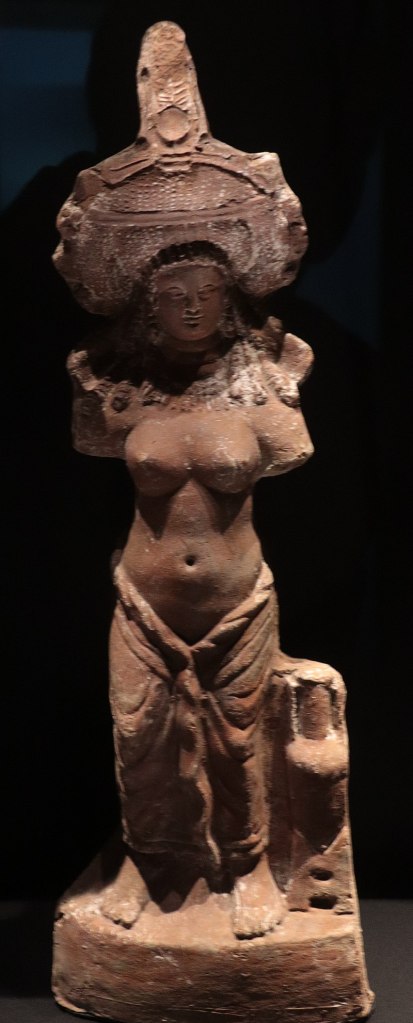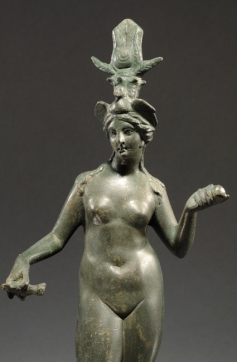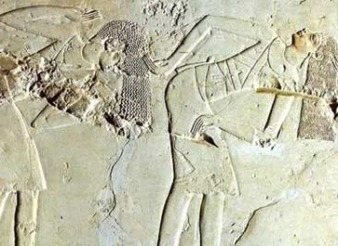In ancient Egyptian, there was a phrase that expressed the all-encompassing nature of Isis: Iset em Renus Nebu, “Isis in All Her Names.” By later periods of Her worship—within Egypt as well as throughout the Mediterranean world—Isis was understood as an All-Goddess Who could be seen in many other Goddesses. Her multi-faceted nature was expressed in a vast array of epithets attesting to Her Divine powers.
When we enter into a relationship with a Deity, that Deity will inevitably expand for us as we learn more about Them and develop our understanding of Them. Perhaps we first greet Isis as protectress of Osiris and mother of Horus. But then we discover that Her power to do those things is because She is, first and foremost, Great of Magic. As we grow our relationship, She reveals more of Herself to us, She opens more doors to Her Divinity for us.
The same thing happened in ancient times. As She revealed ever more of Her Divinity to Her devotees, She became known, in Greek, as Myrionymos, “Myriad Named,” an almost precise echo of Her earlier Egyptian epithet.
So what I have for you today is an invocation of Isis in some of those myriad names and epithets. It is from one of the Oxyrhynchus papyri, which date roughly to the beginning of the 2nd century CE. For those who might like to look it up, this specific invocation is in Oxyrhynchus Papyrus XI.1380.
But first, let me tell you a bit about the papyri found in Oxyrhynchus, an ancient Egyptian city about ten days journey by water or five by land south of Memphis. The city was once quite beautiful, with colonnaded streets, temples, docks, and irrigated land out into the countryside. Outside of town were the city dumps. In the dumps, an enormous cache of ancient papyri was discovered. And because it never rains in this part of Egypt, everything that was above ground-water level was preserved, long after the city itself had crumbled to dust or been dismantled and reused as building materials. You’ll find more on the papyri here.
In these papyri, we have everything from tax documents to personal letters to books to magical workings and invocations. Blessedly, we have an amazing Invocation of Isis in which She is invoked by Her names and epithets, first in the nomes and cities of Egypt, and then in other parts of the Mediterranean world. The Invocation goes on to offer praises to the Goddess. Scholars think it was written by an initiate of Isis, possibly a priest at Memphis. It was composed in Greek and it ranks as one of the most important Isiac documents ever found. And, of course, a great deal of it is missing. Sigh.
To make it easier to read, I’m going to leave out most of the triple dots (. . .) that indicate places where the papyrus was too damaged to read (except where that doesn’t make sense or is just too intriguing to leave out). Also, I’ll italicize the name or epithet, while leaving the place names un-italicized and break it into paragraphs, something the original does not do. The original was written in Greek, the lingua franca of the time.
The Oxyrhynchus Invocation of Isis the Many-Named Goddess
I invoke Thee, Who at Aphroditopolis art called One; Who art called Bubastis; at Letopolis Magna, One; at Aphroditopolis in the Prosopite Nome, Fleet-Commanding, Many-Shaped, Aphrodite; at Delta, Giver of Favors; at Calamisis, Gentle; at Carene, Affectionate; at Niciu, Immortal, Giver; at Momemphis, Ruler, at Psochemis, Bringer To Harbor; at Mylon, Ruler; at Hermopolis, Of Beautiful Form, Sacred; at Naucratis, Fatherless, Joy, Savior, Almighty, Most Great; at Nithine in the Gynaecopolite Nome, Aphrodite; at Pephremis, Isis, Ruler, Hestia, Lady of Every Country; at Es, Hera, Divine; at Buto, Skilled in Calculation; at Thonis, Love; in the Saite Nome, Victorious, Athena, Nymph; at Caene, Joy; at Sais, Hera, Ruler, Perfect; at Iseum, Isis; at Sebennytus, Inventiveness, Mistress, Hera, Holy…
At Hermopolis, Aphrodite, Queen, Holy; at Diospolis Parva, Ruler; at Bubastus of Old, at Heliopolis, Aphrodite, at Aithribis, Maia, Supporter; at Hiera in the Phthemphuthite Nome, Lotus-Bearing; at Teouchis, Sacred, Mistress; among the Bucoli, Maia; at Xois of Old, Oracular; at Apis, Understanding; at Leuce Acte, Aphrodite, Mouchis [probably “She of Mouchis;” Mouchis was near Aphroditopolis], Eseremphis [Greek version of Egyptian name meaning “Isis the Year”]; at Choatine, Victorious; at …, Skilled in Writing; at Cynopolis in the Busirite Nome, Praxidice [a justice-bringing Goddess]; at Busiris, Fortune, Good; at Hermopolis in the Mendesian Nome, Leader; at Pharbaethus, Of Beautiful Form; at Isidium in the Sethroite Nome, Saviour of Men; at Heracleopolis in the Sethroite Nome, Mistress…
At Phernouphis, Ruler of Cities; at Leontopolis, Serpent, Good; at Tanis, Of Gracious Form, Hera; at Schedia, Inventiveness; at Heracleum, Lady of the Sea; at Canopus, Leader of the Muses; at Menouthis, Truth; at Meniouis, Seated Before Io in Whose Honor . . . Is Founded; at M…Enestium, Most Great, Vulture-Sharped, Aphrodite; at Taposiris, Thauestis [unsure, but may be related to a popular Egyptian name, Thaues or Thauesis, meaning “Of Isis”] Hera, Giver; in the Island, Swiftly Victorious; at Peucestis, Pilot; at Melais, Many-Formed; at Menouphis, Warlike; in the Metelite Nome, Kore; at Charax, Athena; at Plinthine, Hestia; at Pelusium, Bringer To Harbor; in the Casian District Tachnepsis; at the Outlet, Isis, Preserver;
In Arabia, Great Goddess; in the Island, Giver of Victory in Sacred Games; in Lycia, Leto; at Myra in Lycia, Sage, Freedom; at Cnidus, Dispeller of Attack, Discoverer; at Cyrene, Isis; in Crete, Dictynnis; at Chalcedon, Themis; at Rome, Warlike; in the Cyclades Islands, Of Threefold Nature, Artemis; at Patmos, Young; at Paphos, Hallowed, Divine, Gentle; in Chios, Marching; in Salamis, Observer; in Cyprus, All-Bounteous; in Chalcidice, Holy; in Pieria, Youthful; in Asia, Worshipped at the Three Ways; at Petra, Savior; at Hypsele, Most Great; at Rhinocolura, All-Seeing; at Dora, Friendship; at Stratonos Pyrgos Hellas, Good; at Ascalon, Mightiest; at Sinope, Many-Named; at Raphis, Mistress; at Tripolis, Supporter; at Gaza, Abundant…
At Delphi, Best, Fairest; at Bambyce, Atargatis; among the Thracians and in Delos, Many-Named; among the Amazons, Warlike; among the Indians, Maia; among the Thessalians, Moon; among the Persians, Latina; among the Magi, Kore, Thapseusis [this name is hard to make out; possibly a specifically Persian name, possibly a magical name]; at Susa, Nania [possibly a syncretic Isis-Innana]; in Syrophoenicia, Goddess; in Samothrace, Bull-Faced; at Pergamum, Mistress; in Pontus, Immaculate; in Italy, Love of the Gods; in Samos, Sacred; at the Hellespont, Mystic; at Myndus, Divine; in Bithynia, Helen; in Tenedos, Name of the Sun; in Caria, Hekate; in the Troad and at Dindyma, Palentra [also unknown], Unapproachable, Isis; at Berytus, Maia; at Sidon, Astarte; at Ptolemais, Understanding; at Susa in the District of the Red Sea, Sarkounis [unknown]…
Thou Who interpretest first of all by the Fifteen Commandments [the word used in Greek is thesmoi, laws; I really want to know what these 15 Commandments or Laws of Isis are—so far, no one does know], Ruler of the World; Guardian and Guide, and Lady of the Mouths and Rivers and of Seas; Skilled in Writing and Calculations, Understanding; Who Also Bringest Back the Nile Over Every Country; the Beautiful Animal [probably, the Cow] of All the Gods; the Glad Face in Lethe; the Leader of the Muses; the Many-Eyed; the Comely Goddess in Olympus; Ornament of the Female Sex and Affectionate; Providing Sweetness in Assemblies; the “Lock of Hair” in Festivals; the Prosperity of Observers of Lucky Days; Harpocratis [possibly an expression meaning something like the “darling”] of the Gods; All-Ruling in the Procession of the Gods, Emnity-Hating, True Jewel of the Wind and Diadem of Life; By Whose Command Images and Animals of All the Gods, Having … of Thy Name, are Worshiped; O Lady Isis, Greatest of the Gods, First of Names, Io Sothis…
Thou rulest over the Mid-Air and the Immeasurable; Thou devisest the weaving of . . . ; it is also Thy will that women in health come to anchor with men; all the elders sacrifice; all the maidens at Heracleopolis turn to Thee and dedicated the country to Thee; Thou art seen by those who invoke Thee faithfully; from Whom … in virtue of the 365 combined days; gentle and placable is the favor of Thy Two Ordinances [like the Commandments, I want to know!]; Thou bringest the Sun from rising unto setting, and all the Gods are glad; at the rising of the stars the people of the country worship Thee unceasingly and the other sacred animals in the sanctuary of Osiris; they become joyful when they name Thee; the spirits become Thy subjects; [the next few lines are very fragmentary] and Thou bringest decay on what Thou wilt and to the destroyed bringest increase, and Thou purifiest all things; every day Thou didst appoint for joy; Thou … having discovered all the … of wine providest it first in the Festivals of the Gods.
Thou becamest the discoverer of all things wet and dry and cold and hot, of which all things are composed; Thou broughtest back alone Thy Brother, piloting Him safely and burying Him fittingly; Leader of Diadems; Lady of Increase and Decay, Thou didst establish shrines of Isis in all cities for all time; and didst deliver to all human beings observances and a perfect year; and to all human beings in every place, Thou didst show . . . in order that all might know that Thou . . .
Thou didst establish Thy son Horus Apollon everywhere, the youthful Lord of the Whole World and for all time; Thou didst make the power of women equal to that of men; and in the sanctuary Thou didst . . . ; Thou, Lady of the Land, bringest the flood of rivers—in Egypt, the Nile, in Tripolis, the Eleutherus, in India, the Ganges; owing to Whom the whole exists through all rain, every spring, all dew, and snow and all the land and sea; Thou art also the Mistress of All Things Forever; Thou madest the . . . of the Dioscuri; Thou hast dominion over winds and thunders and lightnings and snows; Thou, the Lady of War and Rule, easily destroyest tyrants by trusty counsels; Thou madest great Osiris immortal and delivered to every country religious observances; likewise Thou madest immortal Horus who showed Himself a benefactor and good; Thou art the Lady of Light and Flames… [then the Invocation moves to a praise of Horus, and then it breaks off]
There is much to meditate on here. Perhaps you will be inspired, as I am, to call upon Her in some of these many names—and maybe even add your own to the list. “In Portland, Great of Magic, Queen Isis, Mysterious One…”





















